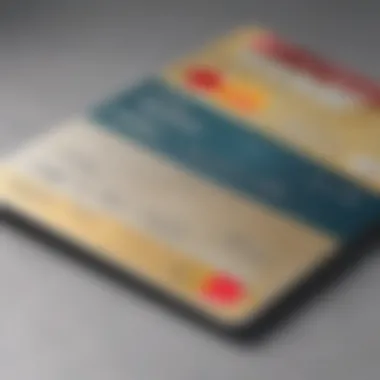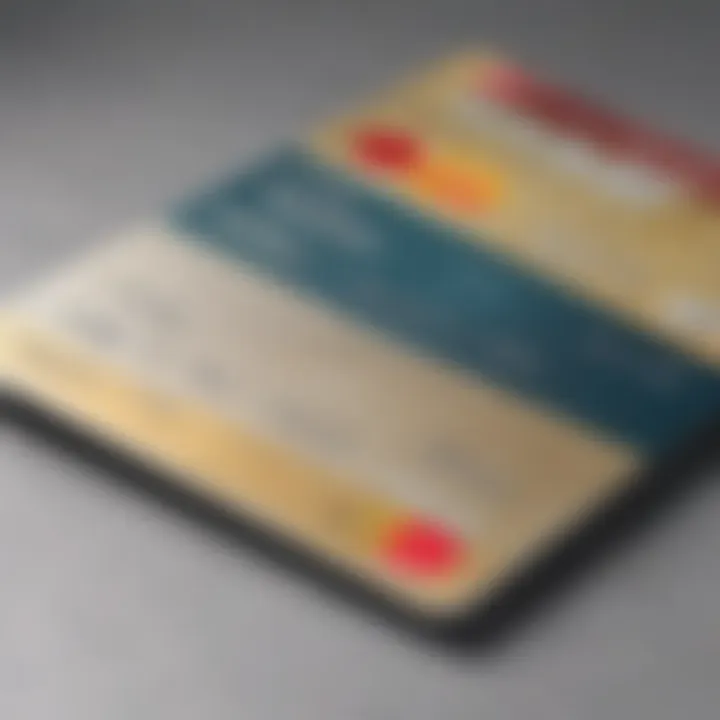The Immediate Effects of Paying Off Credit Card Debt


Intro
When it comes to personal finance, few topics stoke as much discussion among investors and advisors as the management of credit card debt. The decision to settle balances immediately can be as complex as untangling a spaghetti bowl. Is it really beneficial, or could those funds be better allocated elsewhere? In this piece, we peel back the layers on the impacts of paying off credit card debt quickly, digging into both the bright sides and potential pitfalls.
For many, the notion of instantly wiping the slate clean feels liberating. However, it’s essential to understand the broader financial landscape and determine if that immediate payoff aligns well with long-term financial goals. Do interest rates on your debt warrant such prompt action? How might this affect your credit score? And what about your cash flow management?
We will explore these questions in depth, providing insights that are not simply textbook regurgitation. You’ll find a blend of terminology, real-world implications, and strategies that will help you make sound financial decisions as we journey through this analysis.
Preface to Credit Card Debt
Grasping the concept of credit card debt is vital for anyone looking to manage their finances effectively. In today's fast-paced world, credit cards have become a ubiquitous method of transaction. They can be a useful tool, allowing consumers to buy now and pay later, but they also come with the potential for significant debt if not managed prudently. With many people relying on credit cards for everyday purchases, understanding the implications of carrying a balance is crucial for financial health.
Understanding credit card debt encompasses various specific elements and benefits. For instance, credit cards often come with enticing rewards and cashback offers, making them attractive for consumers. However, each swipe of the card can also add to a growing debt burden if payments don’t keep pace with spending. One main consideration is the interest rate, which significantly affects how much you owe over time. The average rate can easily climb into the double digits, leading some individuals to spiral into a cycle of debt that's hard to escape from.
Moreover, credit cards can impact your financial profile overall. This is especially relevant for investors and financial advisors who look at an individual’s creditworthiness. The amount of credit used in relation to limits—known as credit utilization—forms a part of one's credit score. So, an informed approach to credit card use is not just about avoiding debt but also sustaining a healthy financial image.
In summary, comprehending credit card debt is essential because it plays a major role in personal finance management. Whether you're just starting your financial journey or are knee-deep in debt, recognizing the nature of credit card obligation can help forge a path toward better financial decisions.
Understanding Credit Cards
Credit cards are often viewed as a convenient means of making transactions. However, they involve complex terms and conditions that can leave the unprepared in a bind. After all, not all credit cards are created equal. Different issuers offer varied interest rates, rewards programs, and fees. Consumers must read the fine print to truly understand what they might owe down the line.
When one gets a credit card, the expectation is generally straightforward: purchase goods or services and pay the amount back later. However, when this payment is delayed, interest accumulates at alarming rates, leading to hefty outstanding balances. Therefore, understanding the ins and outs of credit card operations becomes imperative for effective debt management.
The Nature of Credit Card Debt
Credit card debt arises when people spend beyond their means and fail to pay off their balances on time. It might appear innocuous at first glance—it’s merely a tool for making purchases—but over time, it can reveal itself to be a double-edged sword. The more you rely on credit cards, the more you risk falling behind on payments. The resulting debt can morph into a significant financial strain.
One of the most critical aspects of credit card debt is its high-interest nature. Many people find themselves caught in a vicious cycle of minimum payments, where they barely make a dent in the principal. As debts accumulate, what appears manageable can quickly escalate into overwhelming obligations. This reality makes it essential for anyone using credit cards to think critically about their spending habits.
Ultimately, being aware of the nature of credit card debt is pivotal. It informs how individuals choose to manage their accounts and makes them more discerning consumers. Those who grasp this concept are better positioned to either avoid unnecessary debt or devise strategies to pay off existing balances. By doing so, they can bolster their financial portfolio and sidestep the pitfalls often associated with credit card usage.
Immediate Payment: A Double-Edged Sword
Paying off credit card debt immediately can seem like a surefire strategy to regain control over finances, yet it often presents a complex landscape of consequences. On one hand, the allure of wiping out balances swiftly sounds appealing, promising a sense of relief and perhaps even financial victory. On the other, this urgent approach may overlook critical financial considerations that could lead to a cash squeeze or derail other impactful financial strategies. Thus, it's important to not only recognize the benefits but also scrutinize the potential pitfalls of quick debt repayment.
Benefits of Paying Off Debt Right Away
Interest Savings
When you pay off credit card debt immediately, one major benefit is the potential for significant interest savings. Credit cards typically come with hefty interest rates that can spiral out of control with each passing month. Thus, by addressing the balance promptly, you cut short the accumulation of interest.
A key characteristic of interest savings is its direct impact on your overall financial health. Saving money on the spiraling interest rates grants you more room in your budget for necessary expenditures rather than funneling your funds into extra charges.
However, it’s worth noting that this savings isn’t infinite. If you have a promotional zero percent interest period, for example, you might want to weigh the urgency of payment against the potential to invest or allocate those funds elsewhere.
Improved Credit Score
Another notable benefit of immediate repayment is the positive effect it can have on your credit score. Credit scoring models thrive on a good payment history and low credit utilization. Paying off your credit card debt promptly can shrink your overall credit utilization ratio, making you appear less risky to lenders.


This improvement in credit standing is crucial, especially if you plan to make major purchases or apply for loans. Being perceived as a responsible borrower can open doors to better loan terms. That said, if you’re not careful with future spending, this temporary gain could be short-lived.
Financial Peace of Mind
On a more psychological note, paying off credit card debt can bring a profound sense of financial peace of mind. Living with the nagging worry of unpaid dues can be stressful; erasing that debt provides a clarity that allows individuals to focus on their broader financial goals.
Furthermore, this peace often extends beyond just the immediate numbers in your bank account. It fosters a mindset of free-flowing financial management, potentially inspiring smarter budgeting and spending habits in the long run. However, relying solely on emotional reassurance without considering ongoing financial health may mislead some into ignoring crucial budgeting for future needs.
Potential Downsides of Immediate Payments
Cash Flow Strain
Despite the benefits, there is a key downside to immediate repayment — cash flow strain. By redirecting significant amounts of cash towards paying off credit card balances, you risk depleting your immediate liquidity. This can hinder your ability to address urgent expenses or unexpected bills that might arise. It is not uncommon for individuals to find themselves in a precarious position, feeling light as a feather but pressed against the wall due to lack of funds for day-to-day living expenses.
Striking a balance is necessary. It’s about evaluating how much of your monthly income should go toward debt repayment versus maintaining enough liquidity for unforeseen circumstances.
Opportunity Costs
Another aspect to consider is the opportunity costs associated with immediate payments. Utilizing available cash to pay off debts right away may prevent investments or other financial growth opportunities that could yield higher returns in the long run. By paying a credit card bill in full, you might miss out on investment strategies, retirement contributions, or even major purchases with larger implications for your financial future.
These lost opportunities can weigh heavily as you reflect on your financial strategy. As enticing as paying off debt may be, it’s prudent to consider whether those funds could have been more effectively deployed elsewhere.
Understanding the nature of immediate payments as a double-edged sword is vital. Each decision carries weight and potential for both positive and negative outcomes. Evaluating your unique financial situation can help illuminate the path that’s best for you.
Financial Context for Credit Card Payments
Understanding the financial context of credit card payments is like knowing the lay of the land before setting out on a journey. At its core, being aware of interest rates, fees, and budgeting can make a significant difference in how individuals manage their debt. This section sheds light on why these financial aspects are crucial when making the decision to pay off credit card debt promptly.
Immediate debt repayment might seem straightforward, but the true ramifications extend beyond the balance owed. Familiarity with interest rates – particularly high ones – helps gauge how much extra one is really paying over time. Additionally, understanding grace periods related to credit cards provides leverage. Furthermore, setting up a sustainable budget not only balances your expenses but enables you to make informed decisions about whether to pay off debt or allocate funds elsewhere.
Interest Rates and Fees
The Impact of High-Interest Rates
High-interest rates can feel like a millstone around the neck, making it challenging to get ahead financially. Credit card issuers often set these rates based on an individual’s creditworthiness, so if you find yourself with a high rate, you've probably incurred some risk from their perspective. This trend makes it all the more pressing to pay off debt quickly. Why? Every day that balance remains unpaid, interest accrues, ballooning total costs beyond your original borrowing.
The key characteristic of high-interest rates is a compounding nature that can easily turn a manageable balance into an overwhelming burden. If one feels pinched by the interest rate, opting for immediate repayments might be the ticket to freedom from a vicious cycle.
Yet, while high-interest rates demonstrate how imperative it is to act, they can also lead to rash decisions. In scrambling to pay off debt before interest runs amok, individuals may overlook other financial obligations. The challenge lies in balancing urgency and strategy, making it essential to consider your overall financial landscape before diving in.
Understanding Grace Periods
Navigating credit cards without knowing about grace periods is like driving a car without checking mirrors. Grace periods refer to the time frame during which you can pay your balance in full without incurring interest charges. This feature is key because it allows time to strategize repayments without the fear of added costs.
Understanding how grace periods work can help you make better choices. For instance, if you charge a purchase but pay it off during this period, you're essentially borrowing at no cost. This highlights the importance of timing your payments. Not only does this contribute positively to cash flow management, it also adds flexibility to your finances.
However, ignorance of grace periods can lead to costly mistakes. If you push payments without knowing when the grace expires, you risk incurring interest that could have been avoided. It's a two-sided coin; utilize the grace period wisely, and your road to financial well-being gains a smoother ride.
Budgeting and Cash Flow Considerations
Creating a Sustainable Budget


Crafting a sustainable budget serves as the bedrock of sound financial management. It involves plotting out income against expenses, thereby setting clear boundaries on spending habits. A well-structured budget helps ensure that individuals can maintain their living standard while actively addressing debt payments.
The essential characteristic of a sustainable budget is its adaptability; it requires regular revision. Regularly assessing your income allows you to see where funds can be redirected towards debt repayment without sacrificing essentials. Having this framework in place establishes a sense of control over finances and ultimately contributes towards quicker debt resolution.
However, there’s a catch. Creating a budget can be time-consuming, especially if you have varied expenses. The process demands diligence and commitment, which can sometimes lead to frustration in the face of ongoing temptations to overspend. Finding that balance—between sticking to the budget and enjoying life—can be a delicate dance.
Essential vs. Non-Essential Expenses
The difference between essential and non-essential expenses is fundamental in understanding where your money goes. Essential expenses cover what you need to live—think rent, utilities, and groceries—while non-essential expenses include things like dining out or gadget upgrades. Recognizing these categories can create clarity in budgeting efforts and money management.
Focusing on essential expenses first allows individuals to make informed choices about where cuts can be made should the need arise. This distinction is essential for anyone looking to pay off credit card debt. Why? Because if you find that you trim back on non-essentials, you free up cash to target debts more aggressively.
On the flip side, it can be tempting to overlook small non-essential expenses. They might feel insignificant on their own, but over time they accumulate and have a tangible impact on your financial health. Adopting a discerning mindset can bolster your efforts to reduce debt effectively, leading to a more robust financial picture.
Credit Score Dynamics
What Factors Influence Credit Scores?
Credit scores are built around several key elements that reflect your borrowing behavior. Two standout factors that significantly sway your credit score are payment history and credit utilization ratios. Knowing how these factors interact with immediate debt repayment helps you navigate your credit landscape more effectively.
The Role of Payment History
The most critical factor in determining your credit score is your payment history. Simply put, this tracks how well you manage to pay your bills on time. It counts for about 35% of your overall credit score. When you pay off credit card debt promptly, it signals to creditors that you are responsible and reliable. This is particularly significant because late payments can linger on your report for seven years.
A key characteristic of payment history is its weighting in credit scoring models. It's not just about whether you’ve paid your bills; it’s about the timeliness and consistency of those payments. For instance, if you were to clear a substantial credit card balance immediately, you could avoid an array of pitfalls associated with high balances and missed payments.
The unique feature here is that even one misstep, such as a missed payment, can have a dramatic effect, pulling your score down like a rock in a pond. So, being proactive about payments can be a beneficial choice. However, if you constantly swipe your card without the ability to pay off your balance, that will ultimately hurt you.
Credit Utilization Ratios
Another essential factor in your credit score is the credit utilization ratio. This ratio represents the amount of credit you are using compared to your overall credit limit. Generally, experts suggest keeping this ratio below 30% to foster a healthy score.
If you pay your credit card debt immediately, you directly impact this ratio. A lower utilization ratio can be particularly appealing to lenders. Why? Because it shows that you are not overly reliant on credit.
A unique aspect of credit utilization is its dynamic nature. As you work to reduce outstanding balances, your utilization ratio improves almost instantly, which can bolster your score in real-time. Yet, be cautious; if you max out your cards and only pay them off in part, or if you close accounts after paying off debts, it can unexpectedly hurt your overall utilization ratio.
In summary, both payment history and credit utilization ratios play a foundational role in shaping your credit score. Immediate repayment can have several advantages, but it is crucial to finely tune your approach to support sustained credit health.
Short-Term vs. Long-Term Impact of Payments
When considering immediate payment of credit card debt, one must delineate between short-term and long-term impacts on credit scores. In the short term, enzyme-like effects might kick in by reducing balances and improving utilization ratios almost on-the-spot. Conversely, the long-term effects work more subtly. A history of timely payments builds up your creditworthiness and establishes trust with lenders, a slow but rewarding process.
Strategic Approaches to Debt Management
Tackling credit card debt is no walk in the park. One important aspect of this journey is having a clear strategy for managing debt. This section highlights the significance of adopting organized methods. It sheds light on which prioritization techniques can help you tackle debt efficiently while considering your overall financial goals. By understanding these approaches, investors, financial advisors, and analysts can guide their decisions more effectively, ultimately leading to better financial health.
Prioritizing Debt Payments
Debt Avalanche vs. Debt Snowball


When it comes to paying off several debts, the Debt Avalanche and Debt Snowball methods often come up. The debt avalanche strategy focuses on paying off debts with the highest interest rates first. It saves you more money in the long run. On the flip side, the debt snowball method suggests paying off the smallest debts first. This can provide a psychological boost as you see debts eliminated quickly.
- Key characteristic of the Debt Avalanche: It systematically reduces high-interest debts. This method is beneficial for those looking to minimize overall costs.
- Unique feature of the Debt Snowball: It encourages quick wins, which can motivate individuals who want to see progress in their debt payoff journey.
Choosing between these methods depends on your comfort level and financial circumstances. Both have their merits, but a tailored approach can lead to more effective outcomes.
Assessing Multiple Debts
Assessing multiple debts is crucial for effective debt management. It involves examining the totality of all your obligations to establish a coherent payment strategy. This process allows individuals to see which debts need immediate attention and how they can be addressed sustainably without causing undue financial strain.
- Key characteristic: It promotes an overall understanding of one's financial landscape, which is essential for informed decisions.
- Unique feature: This method helps in determining whether to focus on one specific debt or distribute payments across several.
In this article, understanding the assessment of multiple debts aids in creating a tailored plan that can optimize repayments based on one’s specific situation.
When to Consider Other Financial Goals
Debt repayment can take center stage, but it’s also vital to strike a balance with other financial aspirations. Recognizing when to redirect focus towards saving or investing can make a significant impact on overall financial well-being.
Building an Emergency Fund
Building an emergency fund should be a priority alongside managing credit card debt. Such a fund acts as a safety net for unforeseen expenses, which is critical for maintaining financial stability. Without one, any unexpected costs can plunge an individual back into debt.
- Key characteristic: An emergency fund provides peace of mind.
- Unique feature: It may seem counterintuitive to save while in debt, but having a cushion can prevent further borrowing.
In context with this article, understanding the timing and balance of building an emergency fund while addressing credit card debt is key for long-term security.
Investing for the Future
Shifting gears to investing is another consideration that comes into play. When debt is under control, setting aside funds for investments can yield potential returns that surpass what’s spent on interest in the long run.
- Key characteristic: Investments can compound over time, leading to greater financial growth.
- Unique feature: This approach can enhance wealth-building once debt levels are at manageable levels.
In this article, recognizing the right moment to pivot from debt payment to investment underscores the importance of strategic financial planning.
Understanding the balance between managing debt, building savings, and investing for future goals is vital for achieving a sound financial future.
The End and Recommendations
As we reach the endpoint of our exploration into the landscape of credit card debt repayment, it's crucial to glean the significance of making informed decisions. Paying off credit card debt immediately can come with its fair share of complications and benefits; understanding these nuances will prepare you for what lies ahead.
This article illustrates how priorities shift depending on individual circumstances, financial goals, and the bigger picture of one's financial ecosystem. The value of assessing personal situations cannot be overstated. Each person's financial narrative is unique; therefore, what may seem like an optimal choice for one individual may not hold true for another. Prioritizing immediate payment can lead to substantial savings on interest but can also strain cash flow, leaving you vulnerable in other areas of your budget.
Weighing Personal Circumstances
When considering whether to pay off credit card debt at once, personal circumstances play a pivotal role. Factors like your current income, existing savings, and emotional comfort with debt should be top of mind.
- Income Stability: A steady job can give you the green light to tackle debt immediately, but if your earnings fluctuate, residing debts might be more manageable in the short term.
- Savings Availability: Having an emergency fund built up? That's great! If not, you might want to think twice about sinking your savings into debt.
- Debt Amount: If the debt is on the higher end, it might be simpler to chip away at it bit by bit rather than putting everything on the line all at once.
Taking stock of these factors helps to create an action plan that aligns best with your current lifestyle and financial objectives.
Final Thoughts on Managing Credit Card Payments
As we wrap it all up, it’s clear that managing credit card payments isn't merely about paying off debt. It encompasses understanding one's broader financial situation. Setting a budget, prioritizing debts, and making strategic choices is what it’s all about. Some key points to ponder include:
- Regular Monitoring: Keep track of your credit score and overall financial health regularlty. Small payments off debt now could lead to enhanced credit in the long run.
- Exploring Options: Not all debts are created equal. Scour through your expenses to see if some debts carry heavier interest rates, thus meriting quicker payoff.
- Engage with Financial Advisors: Sometimes, a fresh perspective can shed light on financial paths you may overlook. A financial advisor can align your strategies with your ultimate goals.
Ultimately, the journey of managing credit card debt is a balancing act. Each decision should reflect your personal values and financial health. Through careful consideration and strategic planning, stepping toward financial freedom becomes an achievable goal.



